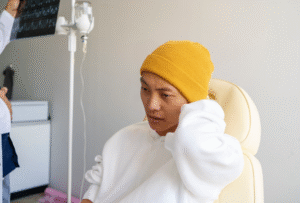Overview
The children’s flu vaccine is an immunization that protects children against influenza, a contagious viral infection affecting the respiratory system. Seasonal flu can lead to serious complications in children, including pneumonia, dehydration, and hospitalization. Vaccination is the most effective preventive measure.
Importance of the children’s flu vaccine:
- Protects children from seasonal influenza infection.
- Reduces the risk of severe illness, hospitalization, and complications.
- Prevents spread of influenza in schools and households.
- Supports community immunity, protecting vulnerable populations such as infants and the elderly.
In South Korea, the flu vaccine is widely available through pediatric clinics, public health centers, and hospitals, with seasonal vaccination campaigns before the influenza season.
Why It’s Done
The children’s flu vaccine is administered to prevent influenza infection and its complications.
Common indications include:
- ➤ Routine annual vaccination for children aged 6 months to 18 years.
- ➤ High-risk children: Those with chronic conditions such as asthma, diabetes, or heart disease.
- ➤ Preventive vaccination before school or daycare attendance.
- ➤ Household contacts of immunocompromised individuals or infants.
Benefits for children:
- ✔️ Reduces risk of flu infection and severe illness.
- ✔️ Lowers hospitalization and complication rates.
- ✔️ Protects family members and peers by limiting viral spread.
- ✔️ Supports healthy growth and development without interruptions from illness.
Alternatives
While vaccination is the primary preventive strategy, other measures complement protection:
- ➤ Hygiene measures: Frequent handwashing, covering coughs and sneezes.
- ➤ Avoiding exposure: Limiting contact with infected individuals during flu season.
- ➤ Antiviral medications: Oseltamivir or zanamivir may be used for treatment or post-exposure prophylaxis.
- ➤ Boosting immunity naturally: Adequate nutrition, sleep, and exercise.
Key point: The flu vaccine offers the most reliable and effective protection, whereas other measures reduce exposure but do not provide immunity.
Preparation
Preparation for the children’s flu vaccine involves screening and minor precautions.
Steps include:
- ✅ Medical history review: Confirm no previous severe allergic reaction to the flu vaccine or components such as egg protein.
- ✅ Current health assessment: Postpone vaccination if the child has moderate or severe illness with fever.
- ✅ Age-appropriate vaccine selection: Inactivated vaccine for children ≥6 months; live attenuated nasal spray for older children if appropriate.
- ✅ Previous vaccination status: Ensure adherence to recommended schedules.
- ✅ Parental counseling: Explain potential side effects and post-vaccine care.
Important: Proper preparation ensures vaccine safety and optimal immune response.
How It’s Done
The children’s flu vaccine can be administered via injection or nasal spray, depending on the child’s age and health.
Step-by-step process:
- Patient positioning: Sitting comfortably on parent’s lap or examination chair.
- Vaccine administration:
- Injection (intramuscular): Usually into the upper arm or thigh.
- Nasal spray: Administered into each nostril for eligible children.
- Observation: Monitor for immediate allergic reactions for 15–30 minutes.
- Documentation: Record vaccine type, lot number, and date.
- Follow-up: Annual vaccination recommended before each influenza season.
Duration: Less than 5 minutes per administration.
Hospital stay: Outpatient; no hospitalization required.
Key point: Vaccine administration is quick, minimally invasive, and generally well-tolerated.
Recovery & Post-Vaccination Care
Recovery from vaccination is rapid with minimal side effects.
Immediate post-vaccine reactions:
- Mild pain, redness, or swelling at the injection site.
- Low-grade fever, fatigue, or mild irritability.
- Rare mild nasal congestion or runny nose for nasal spray.
Short-term care:
- Cold compress for injection site discomfort.
- Acetaminophen or other age-appropriate analgesics for mild fever.
- Observe for unusual reactions and contact healthcare provider if necessary.
Long-term protection:
- Annual vaccination ensures updated protection against circulating flu strains.
- Immunity develops within 2 weeks post-vaccination.
Important: Timely vaccination each year is critical due to evolving flu strains.
Possible Complications
The children’s flu vaccine is safe and well-tolerated, with rare complications:
- ⚠️ Mild side effects: Injection site pain, redness, or swelling.
- ⚠️ Low-grade fever, fatigue, or irritability for 1–2 days.
- ⚠️ Mild runny nose or nasal congestion with nasal spray.
- ⚠️ Allergic reactions: Rare, may include hives or anaphylaxis; managed promptly.
- ⚠️ Febrile seizures: Extremely rare in children with high fever.
In South Korea, standardized vaccination protocols and trained staff ensure high safety and minimal complications.
Treatment Options / Clinical Relevance in Korea
The children’s flu vaccine is a key component of South Korea’s preventive healthcare system.
Key features:
- 🏥 Annual vaccination campaigns before the flu season.
- 🏥 Age-appropriate vaccine formulations: Inactivated for infants, live attenuated nasal spray for older children.
- 🏥 High-risk group prioritization: Children with chronic illnesses, healthcare-exposed families.
- 🏥 School-based vaccination programs improve accessibility and coverage.
- 🏥 Public health education campaigns to raise awareness and encourage vaccination.
Hospitals and clinics providing children’s flu vaccination in Korea:
- Seoul National University Hospital – Pediatric vaccination and seasonal campaigns
- Asan Medical Center – Outpatient vaccination and high-risk child programs
- Samsung Medical Center – School-based and community vaccination initiatives
- Public health centers nationwide – Broad access for all age groups
Highlights in Korea:
- ✔️ Annual vaccination reduces influenza incidence and complications.
- ✔️ High coverage ensures community protection and herd immunity.
- ✔️ Early vaccination minimizes hospitalizations and severe outcomes.
- ✔️ Monitoring and follow-up ensure safe and effective immunization.
Highlights
- ➤ Children’s flu vaccine prevents influenza infection and complications.
- ➤ Recommended annually for children 6 months to 18 years, with high-risk prioritization.
- ➤ Preparation involves screening for allergies, current illness, and vaccine eligibility.
- ➤ Administration is quick, via injection or nasal spray, with minimal discomfort.
- ➤ Recovery is rapid, with mild, short-term side effects.
- ➤ Rare complications include allergic reactions, mild fever, or injection site discomfort.
- ➤ South Korea provides nationwide vaccination programs, school-based initiatives, and public health campaigns to ensure protection and high coverage.













